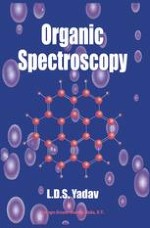2005 | OriginalPaper | Buchkapitel
Spectroscopic Solutions of Structural Problems
Aktivieren Sie unsere intelligente Suche, um passende Fachinhalte oder Patente zu finden.
Wählen Sie Textabschnitte aus um mit Künstlicher Intelligenz passenden Patente zu finden. powered by
Markieren Sie Textabschnitte, um KI-gestützt weitere passende Inhalte zu finden. powered by
Various spectroscopic methods described in this book provide sufficient information for the structure determination of organic compounds. A general approach to solving structural problems by a combination of spectroscopic methods is given as follows:
1.
Molecular formula and molecular weight of a compound is known from its elemental analysis and mass spectrum. The molecular formula gives an idea about the number and kinds of possible functional groups.
2.
Index of hydrogen deficiency is determined from the molecular formula that gives the sum of multiple bonds and rings in the compound (Section 8.8(i)). It helps in limiting the possibilities of structures for further consideration.
3.
The UV spectrum gives indication about the presence (or absence) of a conjugated system, an aromatic ring, a carbonyl group (aldehydic or ketonic) etc.
4.
The IR spectrum shows the presence (or absence) of certain functional groups, e.g. carbonyl groups, hydroxyl groups, -NH- etc., and C≡C and C=C bonds.
5.
The PMR spectrum reveals the environment of hydrogen atoms in the molecule. It gives the number and kinds of protons present in the molecule. Spin-spin splitting tells about the neighboring protons. In brief, we should examine the PMR spectrum for the presence of —CH
3
, CH
3
CH
2
—, —CH
2
—CH
2
, (CH
3
)
2
CH—, —CH=CH—, —C≡CH etc. groups; aromatic protons, and protons on heteroatoms, i.e. exchangeable protons. Thus, the PMR spectrum leads to some extent to the molecular skeleton.
6.
The CMR spectrum gives the number of kinds of carbons, and the number of methine carbons, methylene carbons, methyl carbons, and carbons having no hydrogen. Thus, the CMR suggests the carbon skeleton of the molecule.
7.
The mass spectrum, in addition to molecular weight, shows the presence of certain structural units, and the fragmentation pattern indicates their points of attachment in the molecule.
